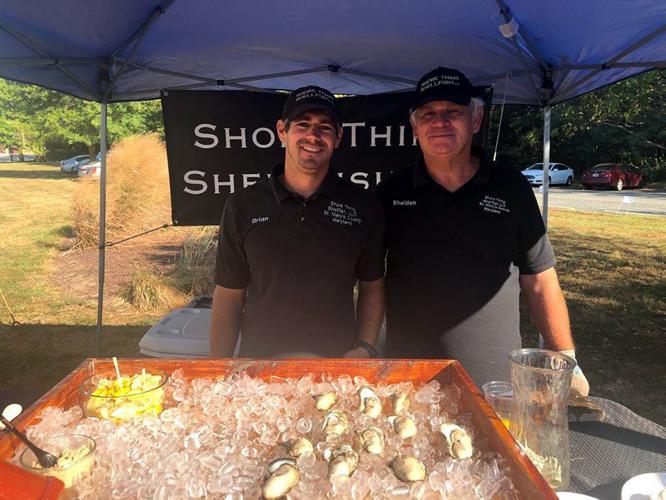ST. LEONARD, Md. — If you follow Route 4 south through the southern portion of Calvert County, Maryland, and turn onto the winding road that leads through the expansive fields and woods of Jefferson Patterson Park, the gravel drive will eventually lead you to PEARL — the Patuxent Environmental and Aquatic Research Laboratory, that is.
PEARL is located on the Patuxent River, which is part of the Chesapeake Bay watershed. Research conducted at the state-of-the art facility is designed to increase the understanding of coastal ecosystems so that they may be properly managed and protected. Their mission is “to provide society with the knowledge to solve its environmental challenges through research, education and economic development.” Much of their work is focused on the Chesapeake Bay and its tributaries.

Guests make their way down the dock to board one of the larger PEARL research vessels for a quick river tour of the Patuxent.
Founded in 1967 by The Academy of Natural Sciences, PEARL was originally located in Benedict. The program was moved to the current facility in St. Leonard in 1994, and became a part of the Morgan State University System in September 2004.
PEARL director Scott Knoche commented in his latest newsletter on the link between the main Morgan State University campus and the important work being done at the southern laboratory, saying, “While summertime can be a slower time for the on-campus set, it is peak season at the Morgan PEARL. Our interns — nine of them this summer — are providing a blast of energy, enthusiasm and critical support on a variety of research projects. These projects include oyster genetics research, a blue crab survey in its 51st year, and a project to create living shorelines through establishing oyster colonies on hard-surfaced waterfront property.”
Summer is also a busy time for the oyster aquaculture program at PEARL. While this immediate season throughout the state has been dry, the record setting rains from 2018 have caused an unusually low salinity in the waters of the Chesapeake Bay watershed. Wild-catch watermen and oyster aquaculture farmers alike have been facing the challenges that this has caused for the oyster hatcheries, and reports have come in that natural oyster reproduction has been impacted in waters all across the state.
In response to those challenges, the aquaculture team at PEARL, driven by Shellfish Genomics expert Ming Liu and Amber DeMarr have been working to produce a line of low-salinity tolerant oysters. Knoche is “happy to report that they have successfully produced juvenile oysters.”
Oyster aquaculture production is considered to be a farming enterprise in Maryland, as the producers are farming the local waters. Therefore they also work with local agricultural groups such as the Southern Maryland Agricultural Development Commission, a division of the Tri-County Council for Southern Maryland. SMADC recently adopted the management of the Southern Maryland Oyster Guide website, at the invitation of the project originators, PEARL, and partners St. Mary’s and Calvert County economic development and tourism departments, and environmental nonprofit True Oyster Restoration Initiative Inc.

A researcher showcases one of the studies to a guest on the porch of the PEARL lab building.
The Southern Maryland Oyster Guide website and corresponding rack card are a tourism marketing catalyst to increase public appreciation for oyster farming; where and how oysters are grown and harvested; as well as the economic, cultural, gastronomic and ecological assets the oyster industry contributes to the region.
“SMADC was awarded a Rural Maryland Council grant to build on the good work already started by PEARL, and we expanded the website content to be more appealing to consumers, and to also include both farmed and wild harvest oyster producers regionwide.” explained Susan McQuilkin, marketing specialist at SMADC and the project head. “Since its launch, the somdoysterguide.com website has received nothing but praise from those in the industry, and is working hard to promote the entire southern Maryland oyster community.”
The work that PEARL and their affiliates do all year was on full display at the annual PEARL open house on Friday, Oct. 4. A fun-filled event with games, tours of the working labs, and boat rides on the research vessels, it is well attended every year, with the fresh oyster shucking and tasting conducted by Shore Thing Shellfish being one of the highlights of the day.
“The open house is always well attended by a broad spectrum of folks who support this unique facility, and its faculty and staff,” said Brian Russell of Shore Thing Shellfish. “The PEARL Lab has been very supportive of aquaculture in southern Maryland, and we hope that they will be able to continue their research and support of this every growing industry.”
Although the open house has a fun, festival-like atmosphere, it also draws attention to the work that PEARL carries out.
Jon Farrington, PEARL’s new facilities administrator and himself an oyster producer, showcased one of the newest accomplishments at the open house.
“We at PEARL are very excited to have been selected among a consortium of 12 East Coast universities and government agencies collaborating on a 5-year, $4.4 million NOAA/ASMFC grant to accelerate and localize selective breeding in support of oyster aquaculture,” he said, “In particular, the effort at PEARL will be focused upon developing a line of oysters more tolerant of periodic low-salinity conditions, which appears to be happening more frequently in the bay. This line will be developed with assistance from local oyster farmers, who will cooperate with field trials of the oysters in the selective breeding process.”




